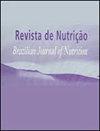妊娠期体重增加的不足:患病率及其与社会人口特征和生活环境的关系
IF 0.5
4区 医学
Q4 NUTRITION & DIETETICS
Revista De Nutricao-brazilian Journal of Nutrition
Pub Date : 2022-01-01
DOI:10.1590/1678-9865202235e210156
引用次数: 0
摘要
【摘要】目的探讨妊娠期体重增加不足与社会人口学指标和生活环境特征的关系。方法对2019年在圣卡塔琳娜州统一卫生系统妇产医院分娩的3580名产后妇女进行了横断面研究。计算患病率,并使用逻辑回归模型,根据社会人口学和健康指标(体重指数、年龄、婚姻状况、种族/肤色和教育程度)估计妊娠期体重增加不足和适当的奇比;以及社区的特点(暴力、社会凝聚力、鼓励锻炼身体和获得健康食品)。结果29.6%的孕妇妊娠增重充足,29.3%的孕妇妊娠增重不足,41.1%的孕妇妊娠增重过高。怀孕前体重指数被归类为超重(43.0%)和肥胖(58.0%)的妇女,以及生活在社会凝聚力强的环境中的妇女(25.0%),体重适当增加的机会较低。相比之下,接受过12年及以上教育的女性体重增加的几率比接受过8年及以下教育的女性高43.0%。结论妊娠期体重增加不足与孕前体重指数偏高、生活环境社会凝聚力差、孕妇受教育程度低有关,需要制定超越产前护理的公共政策。本文章由计算机程序翻译,如有差异,请以英文原文为准。
Inadequacies of gestational weight gain: prevalence and association with sociodemographic characteristics and the living environment
ABSTRACT Objective To assess the association of gestational weight gain inadequacies with sociodemographic indicators and characteristics of the living environment. Methods Cross-sectional study conducted in 2019 with a probabilistic sample of 3580 postpartum women who gave birth in maternity hospitals of the Unified Health System in the State of Santa Catarina. Prevalence was calculated and, using logistic regression models, odd ratios of inadequate and adequate gestational weight gain were estimated according to sociodemographic and health indicators (Body Mass Index, age, marital status, race/skin color and education); and characteristics of the neighborhood (violence, social cohesion, encouragement to practice physical activity and access to healthy food). Results It was observed that 29.6% of the mothers had adequate gestational weight gain, 29.3% insufficient and 41.1% excessive gestational weight gain. Lower chances of adequate weight gain were found in women with pre-pregnancy body mass index classified as overweight (43.0%) and obesity (58.0%) and who lived in an environment with social cohesion (25.0%). In contrast, the chances of adequate weight gain were 43.0% higher among women with 12 years of schooling or more when compared to those with 8 years or less. Conclusion Inadequate gestational weight gain is associated with high pre-pregnancy body mass index, with social cohesion in the living environment and with a low level of education of the pregnant woman, requiring public policies that go beyond prenatal care.
求助全文
通过发布文献求助,成功后即可免费获取论文全文。
去求助
来源期刊
CiteScore
1.20
自引率
12.50%
发文量
24
审稿时长
6-12 weeks
期刊介绍:
Revista de Nutrição is former Revista de Nutrição da Puccamp, founded in 1988. It is a bimonthly publication every four months and it is of responsibility of the Centro de Ciências da Vida, da Pontifícia Universidade Católica de Campinas . It publishes articles that contribute to the study of Nutrition in its many sub-areas and interfaces; and is open to contributions of the national and international scientific communities.

 求助内容:
求助内容: 应助结果提醒方式:
应助结果提醒方式:


